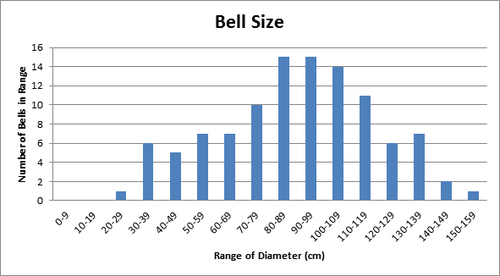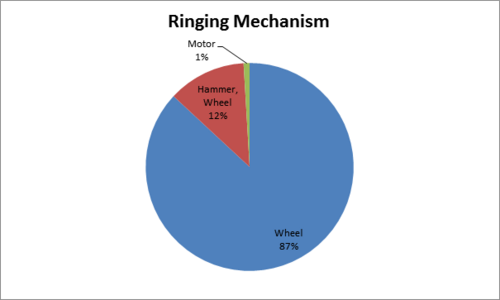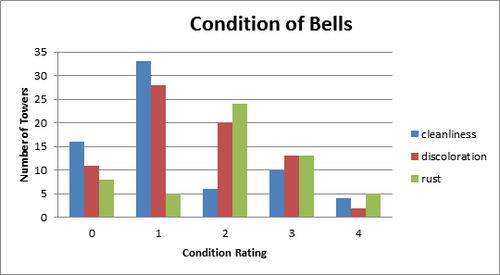Bells
This page is an overview of all the bells in Venice. For a typical bell, see Bell.
Venice has 229 bells spread throughout the city and lagoon.
History
The beginning of bell creation and use dates back to 132 A.D. in China.The idea came from a Chinese philosopher by the name of Chang Heng, who invented the first known earthquake detector. He then connected a ringing device to the arm that moved during earthquakes so that a ring would be sounded during large seismic activity.
From China, the technology spread to the West, where it was used in church towers across Europe and the Western world.
For more information about bell history, see our External Links.
Statistics
Venice has 229 documented bells which have been visited by Venice Project Center groups. The collected data helps illuminate many aspects of the bells, such as their conditions, commonalities, age, number, and size. By examining the conditional ratings of bells for trends, it is possible to determine the urgency for renovation across the city. It can also be determined if these trends have any correlation to the bell's founder or date of casting.
Bell Sizes
The largest bell documented from Venice is Bell #2 of Sant’ Elena, which has a diameter of 152 cm, and the smallest bell documented is Bell #4 of San Nicolò dei Mendicoli with a diameter of 21 cm.

From the graph above, it can be determined that the most frequent bell diameter ranges from 80 to 99 cm. Ironically, the shape of the graph is approximately a bell curve. The average ratio of diameter to internal bell height is 1.22 with a standard deviation of 0.106. Therefore, the size of the bells may vary, but the shape is similar for all bells in the city.
Ringing Methods
Most bells in the city employ the same type of ringing method. The use of a wheel or a hammer are the two most common forms of ringing. However, ringing with a wheel is most often used, as 87% of the bells in Venice are rung by wheel. The second most common form are bells rung by both wheel and hammer, with 12% of bells employing this method. The graph below illustrates the share of these ringing mechanisms for the bells of Venice.

Bell Condition
Because bells are an integral part of the material culture of Venice, it is important to track the their condition so it is possible to determine when and to what extent renovation is needed. As discussed in the Bell article, the materials that bells are made from, although durable, are still vulnerable to chipping, cracking, discoloration, corrosion, and rust. These condition criteria have been rated on a scale of 0 to 4: 0 indicates there is no need for restoration; 4 that restoration is urgent.

The majority of the bells measured have a conditional rating of 1 for both cleanliness and discoloration. This means that there is some discoloration and dirtiness but not a problematic amount. Rust had a slightly higher rating of 2, though this is still relatively minor. The bells that need restoration should have a rating of 4 for each category. Fortunately, there are 5 or fewer bells for each of the categories with ratings of 4. There seems to be little correlation between the three categories. While there seems to be a great number of bells with a certain rating for one category, there may only be a few rated the same in a different category. Perhaps, when considering a bell for restoration, only one type of deterioration must be remedied. However, from the data there are some bells with a rating of 4 in all categories, such as those in the bell tower of San Silvestro.
See Also
References
External Links
- Wikipedia Bell page
- UK Central Council of Church Bell Ringers
- Verdin Bells & Clocks
- AmeriClock Inc., Church Bell Ringing & Bell Strikers